29 Oct Papua New Guinea — Dancing Skeletons and Mudmen
The outside world didn’t make contact with the Chimbu Skeleton People of New Guinea
.
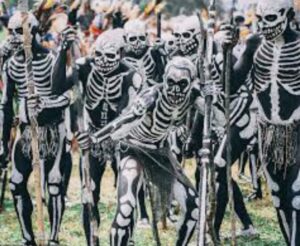
.
until 1934, and nobody seems to have learned much about them since. At least nobody that Peggy and I met. Only that they live at about 7800 feet in the cloud forests of the eastern Highlands,
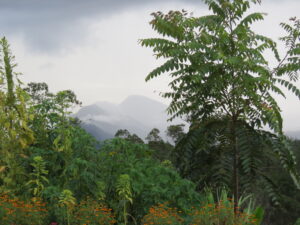
.
But that isn’t saying much . . . rectangular and oval houses, dirt floors, thatched roofs and walls of flattened reeds being pretty much de rigueur in this part of the world.
Also, nobody knows for sure why they paint themselves like skeletons, except that it probably has something do do with warfare, warfare being the principle diversion in Highland New Guinea. And that being painted up like skeletons makes even the most easy-going warrior look scary. But paint themselves up they do,
.

.
complete with blackened sockets around the eyes and pointy teeth. And there they were at Paiya in all their skeletonness, patrolling down a grassy knoll, looking this way
.
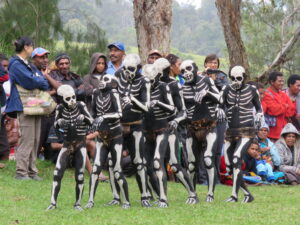
and that
.
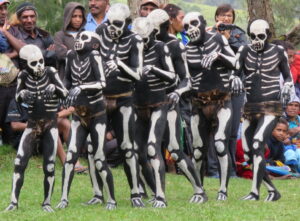
.
like wary infantry making their way through enemy country.
Paiya is situated on the wooded down-slope of Mt Hagen and, with a sing-sing going on, there weren’t just Skeleton People, there were ranks of warriors
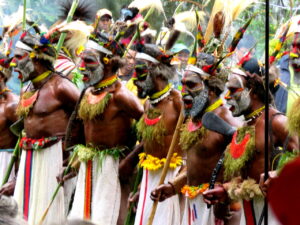
.
fierce and gorgeous in flowers and pectorals, crowned with feathers and carrying wicked-looking spears dancing up a mud track from somewhere in the jungle.
Back on the knoll, a line of Huli Wigmen
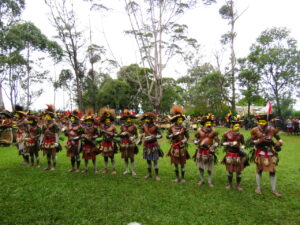
.
made its way toward where we were watching, their faces yellow, wearing wigs formed from their own hair, feathers hanging from their waists and looking like a regiment of those other Highlanders, the ones from Scotland.
A line of women
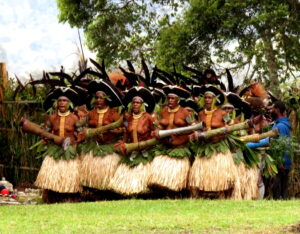
.
in grass skirts beat drums, while their sisters
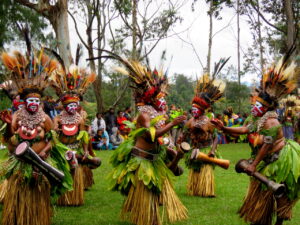
.
from a different tribe, sporting enormous headdresses, danced in a circle beating more drums, followed by men from still other tribes,

.
as fine-looking and as martial as the ones who’d danced up the jungle track.
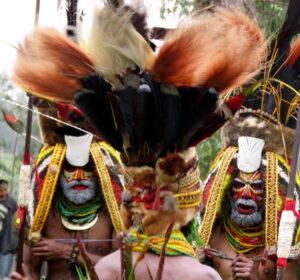
.
I say unto you that even Solomon in all his glory was not arrayed like one of these.
And, then, there were Mudmen.
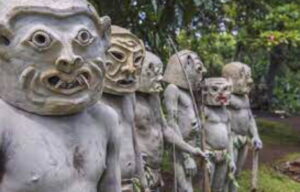
.
as wary as if they’d taken a page out of the Dancing Skeleton Manual of Infantry Tactics.
.
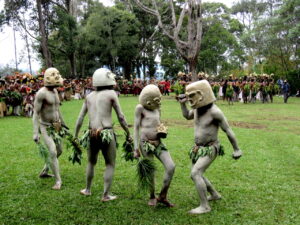
None of us outsiders knew much more about Mudmen than we did about the Dancing Skeletons, except that they live near the village of Garoka. How they came to cover themselves with mud has never been fully explained to me.
Or, rather, there have been too many explanations. One involves a guy who, having arrived at a wedding with nothing appropriate to wear, smeared himself with mud. Given the birds of paradise feathers, and colorful cloths, bright paints, flowers and clattering shells Papuans sport on festive occasions, and the ferocity for which tribesmen are known, it wouldn’t have been my choice to show up at a wedding dressed in mud. Whatever, the other guests mistook him for a ghost and ran away. Which suggested that such attire might be useful in battle.
Another story involves a group of warriors who, losing a battle, fled into the Asaro River. At sunset, they climbed back out
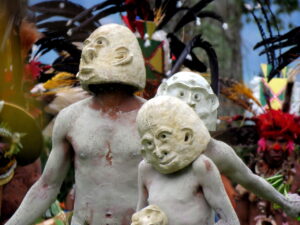
.
covered with mud and the enemy, mistaking them for spirits, ran away.
The Mudmen, knowing a good trick when they pulled one, played up the story with dark whispers about a man in the river who gave them eyes with the power to kill. Now, with mud thoroughly ingrained in their public image, they attend sing-sings dressed like mud-colored spirits sporting little wreaths of foliage around their private parts.
For all we could tell, they brought along jars of Genuine Asaro River Mud to slather on their bodies at the sing-sing, but they didn’t put it in on their faces. In Mudman lore, mud from the Asaro is poisonous, so they wear prefab masks made by heating gravel in the water from a waterfall
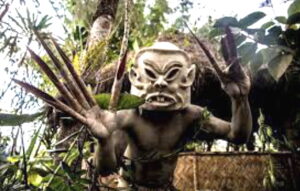
.
and, when the notion strikes them, enhancing the effect with shells and pigs teeth. It doesn’t hurt that fashioning masks ahead of time gives them a better opportunity to create death-dealing eyes than they’d get by daubing mud on their faces before a battle. Or, for that matter, before a sing-sing.
.


No Comments